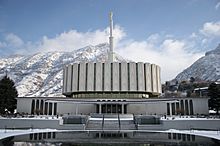Provo Utah Temple facts for kids
| Provo Utah Temple | ||||||||||||||||||||||||||||||||||||||||||||
|---|---|---|---|---|---|---|---|---|---|---|---|---|---|---|---|---|---|---|---|---|---|---|---|---|---|---|---|---|---|---|---|---|---|---|---|---|---|---|---|---|---|---|---|---|
 |
||||||||||||||||||||||||||||||||||||||||||||
| Number | 15 | |||||||||||||||||||||||||||||||||||||||||||
| Dedicated | Quick facts for kids February 9, 1972 byJoseph Fielding Smith |
|||||||||||||||||||||||||||||||||||||||||||
| Site | 17 acres (6.9 hectares) | |||||||||||||||||||||||||||||||||||||||||||
| Floor area | 128,325 sq ft (11,922 m2) | |||||||||||||||||||||||||||||||||||||||||||
| Height | 175 ft (53 m) | |||||||||||||||||||||||||||||||||||||||||||
| Preceded by | Ogden Utah Temple | |||||||||||||||||||||||||||||||||||||||||||
| Followed by | Washington D.C. Temple | |||||||||||||||||||||||||||||||||||||||||||
| Official website: https://www.churchofjesuschrist.org/temples/details/provo-utah-temple • News & images | ||||||||||||||||||||||||||||||||||||||||||||
|
||||||||||||||||||||||||||||||||||||||||||||
The Provo Utah Temple (formerly the Provo Temple) is the 17th constructed and 15th operating temple of The Church of Jesus Christ of Latter-day Saints (LDS Church). Located in the city of Provo, Utah, it was built with a modern single-spire design, similar to the original design of the Ogden Utah Temple.
History
Since Provo's early years, a hill just northeast of downtown Provo was known as "Temple Hill." Instead of a temple, however, the Maeser Building was built on the hill in 1911 as a part of the Brigham Young University (BYU) campus. A 17-acre (69,000 m2) block of property at the base of Rock Canyon was chosen as the site for the Provo Temple.
The LDS Church announced the intention to construct a temple in Provo on August 14, 1967. A groundbreaking ceremony, to signify the beginning of construction, was held on September 15, 1969. The temple was dedicated on February 9, 1972, by LDS Church president Joseph Fielding Smith. The two dedicatory services were broadcast to several large auditoriums on the BYU campus, including the 22,700-seat Marriott Center. Thirty-one years after the temple's completion, a statue of the Angel Moroni was added to the spire, which itself was changed from gold to white.
Emil B. Fetzer, the architect for the Ogden and Provo temples, was asked to create a functional design with efficiency, convenience, and reasonable cost as key factors. The design of the temple was inspired by a scripture in Exodus 13:21 which describes the Lord going before the children of Israel by day as a cloud and by night as a pillar of fire. The panels on the sides of the temple feature a gothic arch motiff, commonly used in religious architecture. The temple has 6 ordinance rooms and 12 sealing rooms, all surrounded by a circular hallway, and has a total floor area of 128,325 square feet (11,921.8 m2).
In large part because of its location across the street from a Missionary Training Center and proximity to the BYU campus, the Provo Utah Temple is one of the church's busiest. In 2016, the Provo City Center Temple was dedicated, making Provo the second city, following South Jordan, Utah, to have two active temples in the world. The two temples are 2.4 miles apart.
In 2020, like all the church's temples, the Provo Utah Temple was closed for a time in response to the coronavirus pandemic.
Temple presidents
Notable temple presidents have included: A. Theodore Tuttle (1980–82); J. Elliot Cameron (1989–92); Dean L. Larsen (1998–2001); Merrill J. Bateman (2007–10); Robert H. Daines III (2010–13); and Alan Ashton (2013–2016). As of November 2016, Donald H. Livingstone is the current president.
See also
 In Spanish: Templo de Provo (Utah) para niños
In Spanish: Templo de Provo (Utah) para niños

